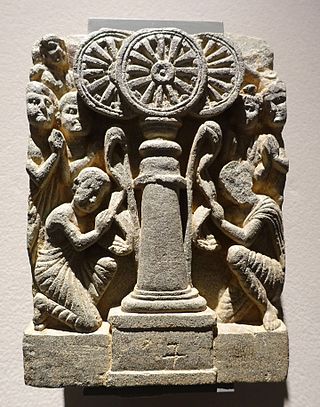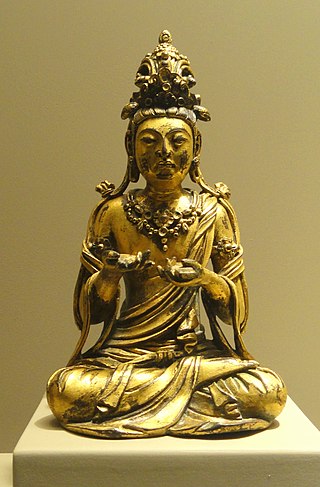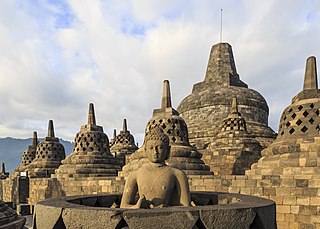Theravāda is the most commonly accepted name of the oldest existing vehicle (yana) of Buddhism, the other name being Hinayana. The vehicle's adherents, termed Theravādins, have preserved their version of Gautama Buddha's teaching or dhamma in the Pāli Canon for over two millennia.
Buddhist eschatology, like many facets of modern Buddhist practice and belief, came into existence during its development in China, and, through the blending of Buddhist cosmological understanding and Daoist eschatological views, created a complex canon of apocalyptic beliefs. These beliefs, although not entirely part of orthodox Buddhism, form an important collection of Chinese Buddhist traditions which bridge the gap between the monastic order and local beliefs of Imperial China.

In Buddhism, refuge or taking refuge refers to a religious practice which often includes a prayer or recitation performed at the beginning of the day or of a practice session. Its object is typically the Three Jewels, which are the Buddha, the Dharma, and the Sangha. Taking refuge is a form of aspiration to lead a life with the Triple Gem at its core. In early Buddhist scriptures, taking refuge is an expression of determination to follow the Buddha's path, but not a relinquishing of responsibility. Refuge is common to all major schools of Buddhism.

Āsāḷha Pūjā is a Theravada Buddhist festival which typically takes place in July, on the full moon of the Āsādha month. It is celebrated in Indonesia, Cambodia, Thailand, Sri Lanka, Laos, Myanmar and in other countries with Theravada Buddhist populations. In Indonesia, the festival is centered at Mendut Temple and Borobudur Temple, Central Java.

Prajñā or paññā is a Buddhist term often translated as "wisdom", "insight", "intelligence", or "understanding". It is described in Buddhist texts as the understanding of the true nature of phenomena. In the context of Buddhist meditation, it is the ability to understand the three characteristics of all things: anicca ("impermanence"), dukkha, and anattā. Mahāyāna texts describe it as the understanding of śūnyatā ("emptiness"). It is part of the Threefold Training in Buddhism, and is one of the ten pāramīs of Theravāda Buddhism and one of the six Mahāyāna pāramitās.

The Abhidhamma Piṭaka is the third of the three divisions of the Pali Tripitaka, the definitive canonical collection of scripture of Theravada Buddhism. The other two parts of the Tripiṭaka are the Vinaya Piṭaka and the Sutta Piṭaka.

Buddhism has a long history in Indonesia, and it is one of the six recognized religions in the country, along with Islam, Christianity, Hinduism and Confucianism. According to 2023 estimates roughly 0.71% of the total citizens of Indonesia were Buddhists, numbering around 2 million. Most Buddhists are concentrated in Jakarta, Riau, Riau Islands, Bangka Belitung, North Sumatra, and West Kalimantan. These totals, however, are probably inflated, as practitioners of Taoism and Chinese folk religion, which are not considered official religions of Indonesia, likely declared themselves as Buddhists on the most recent census. Today, the majority of Buddhists in Indonesia are Chinese and other East Asians, but small communities of native Buddhists also exist.
The Basic Points Unifying the Theravāda and the Mahāyāna is an important Buddhist ecumenical statement created in 1967 during the First Congress of the World Buddhist Sangha Council (WBSC), where its founder Secretary-General, the late Venerable Pandita Pimbure Sorata Thera, requested the Ven. Walpola Rahula to present a concise formula for the unification of all the different Buddhist traditions. This text was then unanimously approved by the council.

Buddhism in Southeast Asia includes a variety of traditions of Buddhism including two main traditions: Mahāyāna Buddhism and Theravāda Buddhism. Historically, Mahāyāna had a prominent position in the region, but in modern times, most countries follow the Theravāda tradition. Southeast Asian countries with a Theravāda Buddhist majority are Thailand, Cambodia, Laos, Myanmar, all of them mainland countries.

The Dhammacakkappavattana Sutta is a Buddhist scripture that is considered by Buddhists to be a record of the first sermon given by Gautama Buddha, the Sermon in the Deer Park at Sarnath. The main topic of this sutta is the Four Noble Truths, which refer to and express the basic orientation of Buddhism in a formulaic expression. This sutta also refers to the Buddhist concepts of the Middle Way, impermanence, and dependent origination.

The Three Ages of Buddhism, also known as the Three Ages of the Dharma, are three divisions of time following Shakyamuni Buddha's death and passing into Nirvana in East Asian Buddhism.

Buddhism is a major religion in Hong Kong and has been greatly influential in the traditional culture of its populace. Among the most prominent Buddhist temples in the city there are the Chi Lin Nunnery in Diamond Hill, built in the Tang dynasty's architectural style; the Po Lin Monastery on Lantau Island, famous for the outdoor bronze statue, Tian Tan Buddha, which attracts a large number of visitors during the weekends and holidays.

Buddhism is a religion and philosophy encompassing a variety of traditions, beliefs and practices, largely based on teachings attributed to Siddhartha Gautama, commonly known as the Buddha, "the awakened one".
The Abhidharma are a collection of Buddhist texts dating from the 3rd century BCE onwards, which contain detailed scholastic presentations of doctrinal material appearing in the canonical Buddhist scriptures and commentaries. It also refers to the scholastic method itself, as well as the field of knowledge that this method is said to study.

Buddhaghosa Mahasthavir was a Nepalese Buddhist monk who worked to revive Theravada Buddhism in Nepal in the 1940s in the face of suppression by the Rana regime.

The banishment of Buddhist monks from Nepal was part of a campaign by the Rana government to suppress the resurgence of Theravada Buddhism in Nepal in the early the 20th century. There were two deportations of monks from Kathmandu, in 1926 and 1944.

Kindo Baha, also known as Kinnu Bāhā, Kindol Bāhāl or Kimdol Bāhāl, is a vihara in Kathmandu which was the hub for the resurgence of Theravada Buddhism in Nepal from the 1920s to the 1940s.

Bodagama Chandima Thero is a Buddhist monk. As of 2015 he taught Theravada Buddhism in Taiwan. With a group of Taiwanese Buddhists, he founded the Theravada Samadhi Education Association in Taipei.

Nalanda Institute is the first Buddhist college in Indonesia. With the ideal of fulfilling the need for Buddhist teachers to educate Buddhist students, the Nalanda Buddhist Education Fund Foundation established the Nalanda Buddhist College in May 1979. Nalanda Institute focuses in nonsectarian Buddhism, meaning that it provides education for either Theravada, Mahayana, or Vajrayana.














